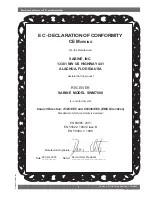
2
Sabine 2.4 GHz Smart Spectrum
®
Wireless
© 2007 Sabine, Inc.
Table of Contents
This operating guide written for receivers using Sabine SWM7000 Remote
Control Software version 2.0 and above.
9. DE-ESSER
31
9.1. De-mystifying De-essers
31
9.2. The Sabine De-esser
31
9.3. Using the De-esser
31
10. PROGRAM SAVE & RECALL
32
10.1. Saving a Preset
32
10.2. Loading a Preset
32
10.3. Naming a Preset
32
10.4. Power Off Memory
32
11. MULTIPLE SYSTEMS OPERATION
33
11.1. Overview
33
11.1.1. Multiple System Interference
33
11.1.2. Setup Complexity
33
11.2. Antenna Distribution Amplifier
34
11.3. Antenna Distribution Amplifier Connection
35
12. EXTENSION ANTENNAS
36
12.1. Overview
36
12.2. Antenna Cabling & Cable Loss
36
13. REMOTE CONTROL OPERATION
38
13.1. Overview
38
13.1.1. Single vs. Multiple Receiver Control
38
13.1.2 Features & Controls Added Software
38
13.1.3. Software Multiple Unit Control
40
13.2. Software Installation
40
13.2.1. Requirements & Recommendations
40
13.2.2. Connections
40
13.2.3. Installing the Software
41
13.3. Launching the software
41
13.3.1. Off-Line Edit/Demo
41
13.3.2. Connecting Receivers.
41
13.4. Remote Control Operation
42
13.4.1. Two Views, Two Sets of Controls
42
13.4.2. Menus, Icons & Hot Keys
42
14. TIPS & TROUBLESHOOTING
46
14.1. Tips for Maximum Performance
46
14.2. Troubleshooting
46
14.3. Common Sources of RF Interference
47
14.3.1 RF Sources
47
15. FBX THEORY & PRACTICE
49
15.1. Introduction to FBX®
49
15.2. The Advantages of FBX Filters
49
15.3. Parametric Filters and FBX
50
15.3.1. The FBX & True Mobility® Advantage
51
14.3.2. FBX Fixed & Dynamic Filters
51
14.3.3. FBX Filter Width
52
14.3.4. Who Benefits from FBX?
52
15. APPENDICES
53
Appendix A: Beltpack Connector Wiring Diagrams
53
Appendix B: Antenna System Diagrams
53
Appendix C: Specifications
54
Appendix D: Dip Switch Settings
55
Appendix E: Frequency Chart
55
Appendix F: Battery Endurance Tests (Typical)
56
Appendix G: Changing Audix Mic Capsules (SW70-H) 56
16. CAUTIONS & WARRANTY
57
INDEX
59
1. INTRODUCTION
3
1.1. Section Contents
3
2. PRODUCT VIEWS
4
2.1. Receivers
4
2.1.1. Front panel views
4
2.1.2. Back panel Views
4
2.2. Transmitters
5
2.2.1. Handheld
5
2.2.2. Beltpack
5
2.3. Components
5
3. QUICK SETUPS
6
3.1. Receiver & Transmitter Quick Setup
6
3.2. FBX Quick Setup
6
3.3. Tips for Good RF Performance
10
3.4. Common Sources of RF Interference
10
4. TRANSMITTER OPERATION
12
4.1. First step
12
4.2. Displays and Settings
12
4.2.1. LCD Display
12
4.2.2. Accessing Transmitter Controls
13
4.2.3. Adjusting Transmitter Settings
14
4.2.4. Transmitter Battery Management
15
5. RECEIVER OPERATION
18
5.1. LCD Display.
18
5.2. Parameter Control & LCD Display
20
5.2.1. One set of Controls for 1 or 2 Channels
20
5.2.2. Channel Select / Contrast Button.
20
5.2.3. Special LCD Display Messages.
21
5.3. RF Channel Select
21
5.4. Output Level
21
5.5. Channel Mixing
21
5.5.1. How to toggle channel mixing mode
21
5.5.2. Controlling the reciever in channel mixing mode
22
5.6. Guitar Cord Simulating
22
5.7. Receiver Antenna Placement
22
5.7.1. Multi-path Interference
22
5.7.2. Receiver & Antenna Placement Tips
22
6. MIC SUPERMODELING™
24
6.1. Introduction
24
6.2. Emulation Choices
24
6.3. Mic Modeling Front Panel Control
24
6.4. Future Microphone Modeling Choices
25
6.4.1. Mic Model Upgrade Instructions
25
7. FBX FEEDBACK EXTERMINATOR®
26
7.1. FBX Introduction
26
7.1.1. FBX Fixed Filters
26
7.1.2. FBX Dynamic Filters
26
7.1.3. Balancing Fixed & Dynamic Filters
26
7.1.4. FBX Filter Width
26
7.2. FBX Set Up
26
7.2. FBX Bypass Button
27
8. COMPRESSOR/LIMITER OPERATION
28
8.1. Basics of Compression
28
8.2. Using the Compressor
28
8.3. Suggested Compression Settings
29
8.3.1. Vocal Settings
29
8.3.2. Guitar Settings
29



































